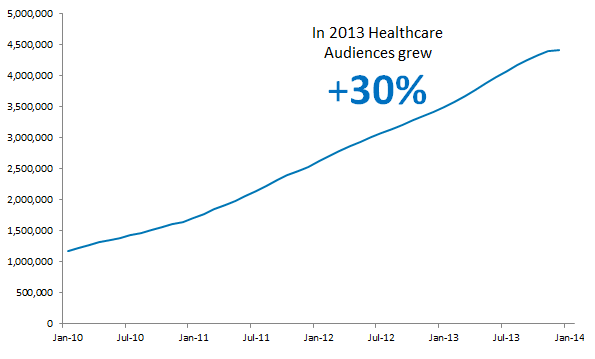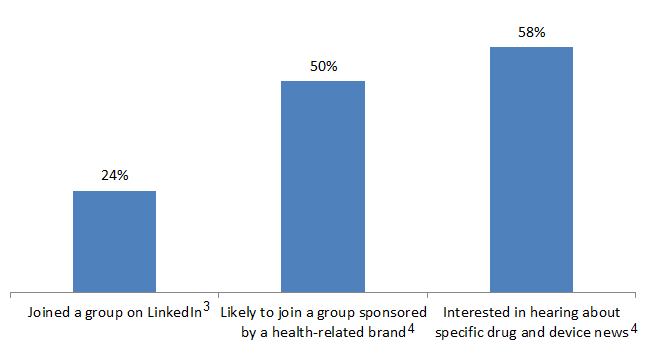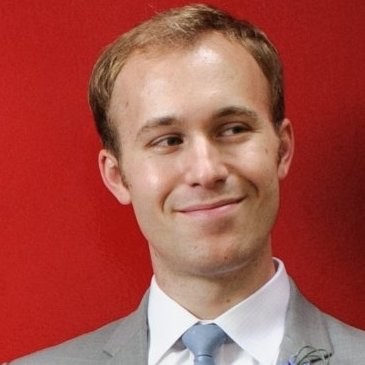Leave Gray’s Anatomy on the Bookshelf: How Modern Healthcare Professionals Engage with Social Media
72% of U.S. Internet users searched online for health information in the past year.1 Whether you are looking up health insurance options, trying to find the best hospital in your area, or researching side effects of medication, the internet can be a great place to start but can often lead to information overload.
Employees in the healthcare industry are in the same situation, inundated with a tremendous amount of information they need to consume to stay educated on evolving regulations, technologies, and treatments. Hardcopy journals or physician-focused websites used to be the go-to resource, but today more and more healthcare professionals are turning to social media sites like LinkedIn for collaborating with peers, ongoing education, coordinating conferences, and to hear from Healthcare Companies directly.
How can companies in the healthcare sector embrace this growing shift towards social media to engage this information-hungry audience? Our latest LinkedIn research provides deeper insights into who these healthcare professionals are and how to reach them.
HEALTHCARE PROFESSIONALS: ON LINKEDIN AND GROWING
Over the past several years, the number of healthcare professionals on LinkedIn and their use of the platform grew at an increasing rate. At the end of 2013, there were over 4.4 million healthcare practitioners, executives, channel followers, and opinion leaders on LinkedIn, a 30% increase in the last year alone.

In the US alone, LinkedIn reaches over 40%2 of Physicians and Surgeons with over 360,000 members who specialize in everything from Pediatrics and Cardiology to Radiology and Anesthesiology. Looking at the larger group of HCP:

This growing use of LinkedIn by healthcare practitioners may be driven by the need for a single location to coordinate networking and education activities that occur in a closed environment, such as LinkedIn private groups. Companies with highly specialized audiences (i.e. Healthcare IT companies, Pharmaceuticals, etc.) can use private groups to effectively communicate with these usually hard to reach professionals where attentive moderators conduct profile reviews of applicants prior to granting membership.
TIPS ON USING LINKEDIN TO ENGAGE HEALTHCARE PROFESSIONALS
Below are a few examples of how specific healthcare industries can use LinkedIn groups to interact with healthcare professionals in a credible place where they are seeking out information to increase their understanding of the medical field:
1. Healthcare IT companies can use groups to start conversations around pain points in the industry, such as Electronic Health Records and Management, and increase awareness around products and information that offer solutions.
- Groups like Healthcare Information Technology and the National Association for Healthcare Quality each have hundreds of discussions every month on a range of Healthcare IT topics.
2. Pharmaceutical companies have a similar opportunity within groups to engage with healthcare professionals around upcoming events and launches.
- Conferences and product launches can be promoted within existing groups or new groups can be created that are dedicated to a specific event, for example Healthcare Conference: A Student Club Conference at Harvard Business School
3. Authentically responding to discussions or starting conversations with group members about what a company is offering and the impact on patients can elevate your image with healthcare professionals more than direct marketing alone.
- Some of the most popular group topics range from how new health tracking tools are changing the way doctors can treat patients to holistic approaches to healthcare.
- Groups such as Continuing Medical Education can be used to highlight education materials and invite discussions on new research findings or upcoming journal articles.
With over 50% of healthcare practitioners likely to join a Group created by a health-related brand, the opportunity is ripe for healthcare companies.
Learn more about what these professionals are doing on the LinkedIn platform and how you can engage with them in our full SlideShare presentation:
Looking ahead, the adoption and usage of social media and LinkedIn -- specifically by the next generation of connected doctors -- are expected to grow. This trend is not unique to healthcare professionals, but is felt by many people in highly specialized, time starved, information hungry industries. Understanding tactics to reach and interact with these individuals in authentic, meaningful ways will be vital to staying competitive and relevant to such rapidly evolving industries.
Sources:
- Source: Based on research conducted by the Pew Internet Project
- Source: Total Physicians/Surgeons on the platform, identified via occupational targeting http://www.nationalahec.org/pdfs/FSMBPhysicianCensus.pdf
- Source: LinkedIn Internal Data, March 2014
- Source: LinkedIn Member Survey Research, November 2013
- Source: AMN Healthcare “Use of Social Media and Mobile by Healthcare Professionals: 2013 Survey Results”


